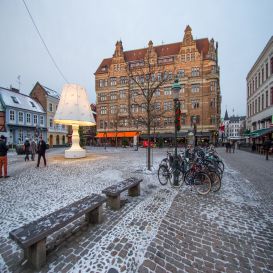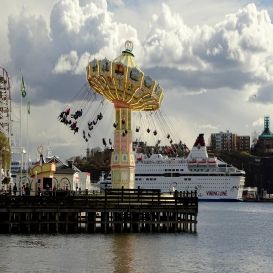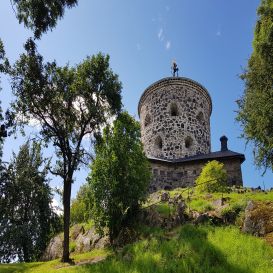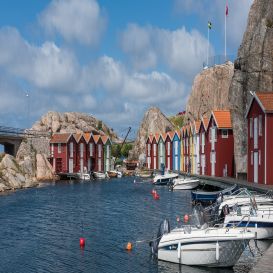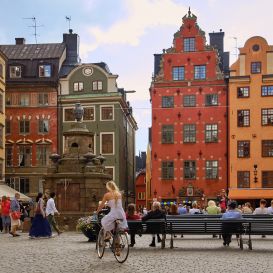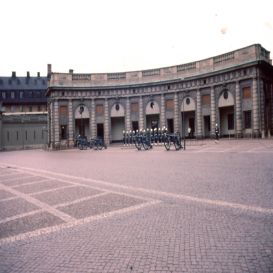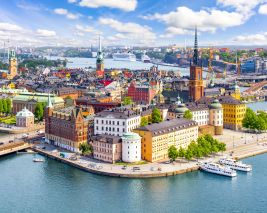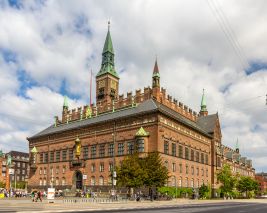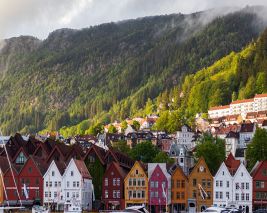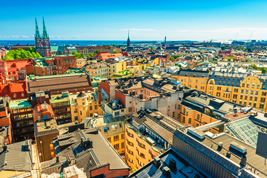Minimalism, Storybook Cities And Ice Hotels
Sweden is a Scandinavian gem That seamlessly blends modern innovation with rich historical traditions. Renowned for its breathtaking landscape, Sweden tourism harmoniously combines natural beauty with vibrant urban life. The country’s innate commitment to sustainability, natural preservation, and talented design ideas further enhance the appeal of Sweden tourism.
Home to reindeer, the Northern Lights, frozen lands, ice hotels and Vikings, Sweden is a wonderful country to visit for travellers looking for a unique cultural experience. Calling its vast landscapes picturesque is an understatement, as the country offers views so stunning that you’ll find yourself wondering whether you’re in a Wes Anderson film! With pristine forests and crystal clear lakes, local beer and delectable meals, you’ll find staying in Sweden is an experience unmatched by anything you’ve seen before. So let’s find out how you can make the most of your trip with or without a Sweden travel guide.
| Sweden Tourism : A Quick Overview |
| Continent |
Europe |
| Capital |
Stockholm |
| Official Language |
Swedish, Finnish, and little english |
| Dial Code |
+46 |
| Population |
10,215,250 |
| Currency |
Swedish Krona |
| Time Zone |
UTC+1 |
| Area |
450,295 km-square |
Highlights of Sweden:
Sweden is an incomparable gem that makes Sweden tour guides extremely popular. Here are the highlights of your Sweden tourism:
- Explore the numerous natural wonders including vast archipelagos, lakes, expansive forests, and beautiful natural elements that constitute the terrain.
- Immerse yourself in the country’s vast, interesting, and rich history. You may even find evidence in its well-preserved medieval towns, royal palaces, ancient sites and the tales of the Sweden tour guides.
- Experience Sweden’s renowned and advanced design and sustainability practices. These are proudly showcased in the country’s architecture, urban planning, and lifestyle.
Now, let’s delve deeper into the wonders of Swedish tourism and how you can make your trip the most memorable experience of your life.
Cities of Sweden:
Stockholm, the capital of Sweden, is actually an archipelago made of 14 gorgeous islands. The sheer novelty of the same is more than enough reason to travel to this city. Surrounded by the sea, this magical city has cobbled streets, vibrant cafes, and great museums for you to visit. It’s also an incredibly trendy city with tons of stores offering classic Swedish minimalist fashion, as well as a score of nightclubs to visit for an unforgettable evening. From an entire museum dedicated to the band ABBA, to Millesgarden and Ostermalm Saluhall (a marketplace that offers impeccable street food), there’s a lot for you to explore here.
If you’re want to travel to a city with a more laid back ambience, then Gothenburg must feature on your list. With its endless canals crisscrossing the streets, the vibrant cultural scene inspires a multitude of events and festivals. With some great marketplaces and a seafood-based cuisine, Gothenburg is a haven for travellers to immerse themselves in Sweden's culture and lifestyle.
Karlskrona is Sweden’s military base, which is why you’ll see a lot of naval architecture all over the city. Most of these buildings date back to the 16th and 17th century and travellers must take part in an official tour to visit them, as they are still in use by the military and access to these buildings is generally restricted. Karlskrona is the third largest city in Sweden, filled with old churches, contemporary shopping malls, bars, and restaurants. If you visit this city during the summer season, make sure to head to its secluded swimming spots and enjoy floating in the sparkling waters.
Travel back in time by visiting Visby, a beautiful medieval city without a single brick of contemporary architecture. You’ll see storybook cottages, cobbled streets, gothic churches, and ruins here, and you simply must visit the Saint Maria Cathedral while exploring this wonderful place!
Finally, if you’re looking for hidden gems, you must make your way to Uema, which is a relatively unknown city in Sweden, in spite of the fact that it was named the European Capital of Culture in 2014. Don't forget to visit its magnificent art galleries, museums dedicated to the Sami people, and the vintage guitar museum when you’re here. This city offers great views of the Northern Lights too, as its located only 400 kms below the Arctic Circle. Spend your time exploring its bustling markets, restaurants and cafes before taking a break in any of its beautiful parks.
Popular tourist spots:
The Vasa Museum sees over 1 million tourists every year and is one of the most popular tourist spots in Sweden. It is dedicated to the battleship Vasa, the pride of the entire fleet, which sank on its maiden voyage. The magnificent ship bid its time in icy waters until it was salvaged in 1961. With more than 10 different exhibitions at this museum, you’ll end up spending the whole day immersing yourself in the beauty of this ship and what it meant to Sweden in 1628.
While you’re immersing yourself in history, do visit Skansen, an open air museum that’s the world’s oldest of its kind. The entire museum is essentially a village, with homes and farmsteads that represent life in the country from various periods ranging from 1720 to 1960s. You’ll get to see old schools, churches, bookstores, artisan’s shops, bakeries, Sami camps and much more, and the experience will certainly feel like something out of Westworld.
Located on the island of Lovo, Drottningholm Palace is a UNESCO World Heritage Site that only 11 kilometers away from the main city of Stockholm. Built in the 17th century, the palace is still operation and currently houses the Swedish Royal Family. The palace also hosts a range of historical artefacts such as a Chinese Pavilion dating back to the 1700s, bronze sculpture and war trophies scattered across its terraced lawn, and the Palace Theatre that dates back to the 18th century. Like the palace itself, the theatre is also fully operational with spectacular shows held here during the summer months.
Head to Kiruna to stay at the fantastic Ice Hotel in Jukkasjärvi. The hotel is rebuilt every year with ice taken from the river Torne. Apart from the unique experience of staying in a hotel made entirely of ice and snow, travellers also visit this city to witness the midnight sun, which makes an appearance from mid-May to mid-July. If you do visit this place in the summer months, make sure you participate in a few fun activities such as rafting, canoeing, stand up paddle boating, and fishing.
Finally, for a thrilling experience, visit the Liseberg theme park and take your pick of its exciting rides like roller coasters, bumper cars, carousels, and much more.
Adventure sports:
During the summer months, you’ll find ample opportunity to indulge in kayaking and canoeing in Gothenburg and Stockholm. However, if you’re expecting a tranquil experience, think again because most rivers in Sweden offer thrilling rapids that will surely get your adrenaline pumping. The Torne, Lule, Kalix and Ume rivers are fantastic ones for the same.
You can also go hiking in the Swedish Lapland for an experience that brings you closer to nature. With over 400 hiking trails spread throughout the area, travelers will varying skill levels are bound to find trails that suit them perfectly. Try your hand at the King’s trail, the most popular hiking trail in the country, along with others like Kebenkaise, Vasaloppet, and Siljansleden.
During the winter months, you can indulge in a range of winter sports like skiing, dog sledding, ice-skating, and snow-mobiling. If you’re a sports buff, you must head down to Are, Central Europe’s largest sports resort, with a variety of trails for newbies and pros.
Cuisine of Sweden:
Of the many dishes available in Swedish cuisine, the smorgasbord is perhaps the most widely known. A buffet of meatballs, sausages, salmon, and other meaty delights, this is something you’ll encounter in every city – and definitely something worth trying more than once! Salad lovers should order a Gubbröra, which is an anchovy and egg salad typically served on thin dark rye bread.
Jansson’s frestelse, also known as Jansson’s Temptation, is a very popular dish made of anchovies, potatoes and cream, and typically eaten around Christmas (though you’ll find it available year-round). Gravlax, which is dill cured salmon, is another immensely popular dish that’s often been described as a foodie's delight. Though the dish owes its origins to France, the Swedish variant comes with mustard, and condiment rarely used in French cuisine. You can order this dish separately, or ask for a smorgasbord that includes thin slices of Gravlax.
If you love all things sweet, order a princess cake or saffron and cinnamon buns for a delightful bite to eat along with your coffee. You should also experiment with the local Swedish beer and try as many variants of coffee as you possibly can!
Interesting facts about Sweden:
Sweden is a cornucopia of advancement, culture, and sustainable living practices. But the country in northern Europe stands out for much more. Here are some interesting but little-known facts that you must explore or learn more about from Sweden travel guides:
- The Nordic country experiences weeks of Midnight Sun and Polar nights when the sun doesn’t set and doesn’t rise respectively.
- Swedish culture is quite subtle and you’re likely to alienate yourself if you use loud body language, descriptive gestures, or even speak too loudly!
- Sweden’s enchanting forests make for 2/3rds of the country’s land and that’s not all – these forests are home to over 300,000 – 400,000 moose that roam freely!
- The country’s biggest export is music, with popular bands and musicians like ABBA, Roxette, Zara Larson, Avicii, Ace of Base, Alcazar, Swedish House Mafia, and many others hailing from this beautiful country.
- Sweden excels so highly at recycling that it even imports waste from other countries to do its bit for the planet.
Location of Sweden:
Sweden is located in Northern Europe. It shares its borders on the west with Norway, to the northeast with Finland, and its Eastern coastline garlands the Baltic Sea. The strategic location of the Nordic country has gained historic significance due to its capability of bridging the gap between Eastern and Western Europe. It influences cultural and economic development with the help of knowledge exchange.
Best time to visit:
- Spring (April to June) - Witness Mother Nature at its finest with blooming flowers and milder temperatures to encourage outdoor activities and explore the places to visit Sweden.
- Summer (July to August) - Enjoy the long daylight hours, especially when traversing through places to visit Sweden above the Arctic Circle. The weather is warm and nearly perfect for outdoor exploration and adventurous activities.
- Autumn (September to October) - Experience the vibrancy of Sweden’s fall foliage and the tranquillity in the atmosphere. You can find Sweden tour guides easily at affordable rates as Sweden tourism thinks at this time.
- Winter (November to March) - Welcome the Northern Lights and embrace winter sports during your Sweden tourism.
The peak season for traveling to Sweden is in the summer months, from May to early September. With long days filled with sunshine, beautiful weather and interesting activities like kayaking, canoeing and hiking on the cards, most travellers enjoy being in this country during this time. Having said that though, the shoulder season is also a great time to visit if you want to avoid running into too many tourists. However, planning your itinerary during the months of October, September, May and April can be quite challenging as snowfall can be unpredictable. So, if you’re planning to travel here during this season, do keep a flexible schedule.
Finally, the winter season from November to March is a great time to visit the country as it’s a haven for winter sports like sledding, skiing, and snowmobiling. Though there’s very little daylight and extremely cold climates, travellers love visiting during these months as they can spot the wonderful Northern Lights.
How to get to Sweden:
By Air: Stockholm Arlanda and Goteborg Landvetter host international airlines from all over the world, and are the best options to get to the country by air. Though Sweden has a few other airports, they are mainly for domestic travel only.
By Train: You can enter the country by taking trains from Denmark, Germany, Finland and Norway. As Sweden is a part of the Schengen Agreement, travellers with a Schengen Visa shouldn’t face any issues crossing the borders.
By Boat: With many Swedish cities being archipelagos, travelling by boat is a norm here. You can hop on cruises and ferries from Denmark, Estonia, Latvia, Finland, Belgium, Russia, Lithuania, Norway, Germany, Poland, and even the UK.
History of Sweden:
Sweden’s history is a tapestry of Viking heritage, medieval power struggles, and modern neutrality.
In the Viking Age, Norse explorers and traders expanded their influence with power and strategy. By the time the medieval ages rolled around, they established a unified kingdom. Sweden has since established a significant role in European history.
Sweden saw a late foray into the industrial revolution, Swedish farming culture has held an important role in determining the politics of the country. As a result, you see a lot of preservation of natural resources. The country remained neutral during both the World Wars, and is still non-aligned from a military point of view.
When planning your Sweden tourism with an experienced Sweden tour guide, make sure to visit the following sites:
Drottningholm Palace -
It is a UNESCO World Heritage Site that serves as the private residence of the Swedish royal family. It is one of the top places to visit Sweden when you plan a trip. It features baroque architecture and beautiful gardens with a stunning landscape of its own.
Gamla Stan in Stockholm (Old Town) -
When you plan on how to reach Sweden, carve out some time to stroll through one of the largest, well-preserved medieval cities in Europe. It features cobblestone pathways and colourful buildings with historic landmarks scattered across its terrain.
Kalmar Castle -
It is a beautiful fortress depicting the Renaissance styling of architecture. It is one of the top places to visit Sweden that dates back over 800 years. During your Sweden tourism, you can get great insights into Sweden’s past conflicts and royal heritage here with the help of an experienced Sweden travel guide.
Vasa Museum -
On your Sweden tourism, don’t miss this 17th-century warship Vasa that remains almost intact. The vessel sank during its maiden voyage but was salvaged centuries later and now stands proudly in the Vasa Museum.
Exploring the country’s cultural and historical depth with Sweden tourism provides a rare glimpse into the role it played in the past. When you plan on how to reach Sweden and the many wondrous places to visit Sweden, immerse yourself in its rich heritage.




















